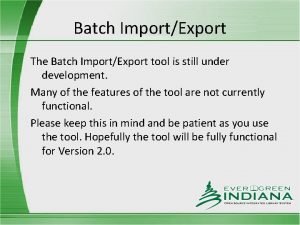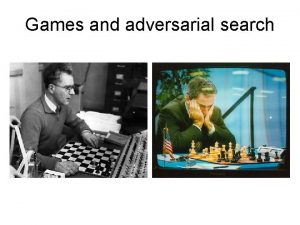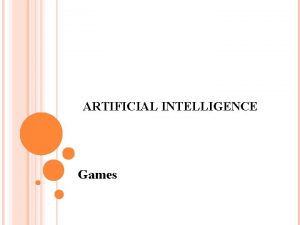Games Development Practices 3 D Model ImportExport CO














- Slides: 14

Games Development Practices 3 D Model Import/Export CO 2301 Games Development 1 Week 16

Today’s Lecture 1. 2. 3. 4. 5. 6. 3 D Model File Formats Writing Export Scripts Commercial Exporters/Converters Dealing with Artists/Designers Common Artwork Problems Ground-rules to Avoid Problems

Saving in Native File Formats • We will use Autodesk Maya to do some simple 3 D modelling – We also have Autodesk 3 DS Max available • It is easy to save scenes in Maya’s own format –. mb for binary files, . ma for ASCII (text) files • However, these formats are not suitable for games: – Data is not optimised for real-time apps, or for hardware support – Maya’s format is effectively a scripted language – Very difficult to parse • Same applies to other modelling packages

Other 3 D Model Formats • Could use another simpler export format… • Many available: –. obj : Wavefront Object file, longstanding simple format – good for basic geometry, but lack of features and rather dated –. X : Microsoft Direct. X file, closely tied to Direct. X and quite simple. Suffers from loose specification and lack of key features (e. g. camera export). –. fbx: Format that originated from motion capture software. Has become quite useful for conversions. However, just like the. X file it suffers from having no formal specification. – Many other open and proprietary formats…

Limitations of other Formats • Each format is lacking in one or more areas, and is unlikely to suit our needs exactly: – We will be limited to the feature-set of the chosen format • Not always built-in support for such formats – E. g. Maya does not support any of these, although Microsoft provide a Maya plug-in exporter for. X files and there are thirdparty exporters also • When there is built-in support, it's often limited or broken – There is a lack of specifications for many 3 D file formats – Animation is particularly hard to export correctly

Writing Export Scripts • 3 D modelling tools often have built in scripting languages – For example, Maya supports MEL (Maya Embedded Language) or the more standard Python language – Can access to the elements in the scene using these languages • Some have a C++ API – Write powerful built-in tools using C++ code • Can use scripts or API to write a custom exporter: – Go through each scene element and write its data to a file • Can write to a known format or specify our own – If we write our own, we will not be able to import into other packages though

Writing Export Scripts for Games • Custom exporters are not unusual in games development • A custom exporter allows us to export richer content from our modelling tool – Camera paths, AI networks, object stats etc. – Although may be better use a level editor for the latter • Add these custom elements to our exporter – Create game-specific files from the modelling tool • This kind of script development falls under the area of Tools Development – It is a common task for Junior Programmers

Exporters/Converters • Microsoft provide a Direct. X exporter for Maya – Also support for 3 D Studio Max – Limited support for the Maya features, and generates a particular variety of Direct. X file – Several other free / commercial exporters, the majority of which focus on particular products • Here we have a license of Poly. Trans (Okino), which can convert between many different formats – It is one of the most general-purpose tools – Fixes broken files and works around format limitations • A useful route for us is to export into the free modelling tool “Blender” and export from there into. X files.

Dealing with Artists/Designers • 3 D engines have specific technical requirements for their 3 D models and other game assets • But artists & designers are not necessarily technicallyminded – Not involved with the details of the 3 D Engine – Cannot be expected to strictly adhere to technical requirements • Two implications: – Explain as clearly and simply as possible any technical requirements for game assets – Deal professionally with misunderstandings and problem artwork

Artwork Requirements 1 • The technical requirements of 3 D Engines fall into several areas: – Supported features: many features of the 3 D modelling package will not be supported in real-time – Polygon budgets: game speed will be affected by having too many polygons – Supported material types: engine will require materials to be built in a particular way • Linked to textures and shaders in the game engine – Geometry restrictions: valid ranges for coordinates, topographical constraints etc. - many issues here – Also: number of lights, overall complexity of scenes etc.

Artwork Requirements 2 • Also common sense requirements: – Sensible sizes for objects, compared to other objects in the game - defining units for the game – Avoiding redundant geometry, e. g. one object hidden inside another, barely visible geometric detail – Avoiding invalid geometry, e. g. cracks in geometry, inside-out objects etc. • Some technical and common sense requirements can be checked by a export script – But problems always slip through

Example Problem Assets • A 180 metre tall character – The artist slipped into centimetre measurement • An entire building hidden inside another one – The designer moved some geometry and lost sight of the extra building • A crate built with 15, 000 polygons – Artist wasn’t given, or ignored the polygon budget – artists often default to “movie mode” • A character with 206 bones in their skeleton – Another budget issue • However, all of these are excusable – Until you can write a program without bugs…

Ground-Rules to Avoid Problems • To avoid these problems, clearly establish a set of asset ground-rules • Specify requirements in a technical design document: – Unit size, e. g. 1 unit = 1 metre – Target poly count for an in game scene – Typical poly counts for different object types, e. g. characters, vehicles, pick-ups – Material requirements, e. g. size of textures, available effects and the relative expense of each – Geometric constraints • Also helps to explain the details face-to-face

More Artwork Ground-Rules • Using an export script you must precisely specify how the modelling tool should be used: – What features are unavailable – How to work with complex features such as animation skeletons or materials – What other game features can be specified, and how – The file formats to be used for output – Tools to use for processing (e. g. normal map generation) • Don’t be lazy – don’t force artists to do unnecessary work that could be done in code. • Also keep artists updated when changes occur in the engine (improvements or restrictions)
 Importexport 2007
Importexport 2007 Importexport 2007
Importexport 2007 Hunger games chapter 9 questions and answers
Hunger games chapter 9 questions and answers Types of games outdoor
Types of games outdoor High potential employee development best practices
High potential employee development best practices Prudent financial management practices
Prudent financial management practices Qlik circular reference
Qlik circular reference Neumans systems theory
Neumans systems theory Using the neuman systems model for best practices
Using the neuman systems model for best practices Game teck
Game teck Role models game
Role models game Contoh model instructional games
Contoh model instructional games Tactical games model
Tactical games model Concentric zone model sector model multiple nuclei model
Concentric zone model sector model multiple nuclei model History of community development in pakistan
History of community development in pakistan



























